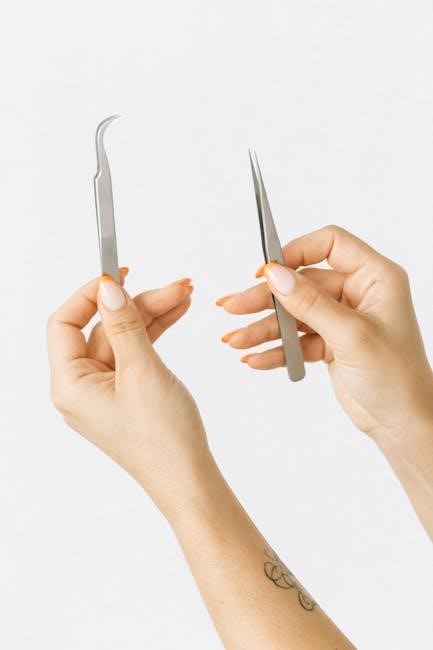Understanding extension cord gauge is crucial for safe usage‚
guides
help determine the right cord for specific devices and lengths‚ ensuring efficient power delivery and preventing overheating issues always matters․
Understanding the Importance of Extension Cord Gauge
Extension cord gauge is a critical aspect of electrical safety and efficiency‚ playing a vital role in preventing overheating‚ fires‚ and damage to devices․ A proper understanding of extension cord gauge helps individuals choose the right cord for their specific needs‚ ensuring reliable power delivery and minimizing risks․ The gauge of an extension cord determines its ability to handle electrical current‚ with thicker cords capable of carrying more power․ Using an extension cord with an inappropriate gauge can lead to reduced performance‚ increased energy consumption‚ and potentially hazardous situations․ By grasping the importance of extension cord gauge‚ users can make informed decisions when selecting and using extension cords‚ ultimately safeguarding their devices‚ property‚ and personal well-being․ This knowledge is essential for homeowners‚ professionals‚ and anyone who relies on extension cords to power their devices‚ making it a fundamental aspect of electrical safety and best practices․ Proper usage and selection are key to optimal performance․

Choosing the Right Extension Cord Length
Extension cord length selection depends on device placement and outlet location‚ requiring careful consideration of power delivery and safety standards always to ensure optimal performance and minimize risks effectively․
Factors to Consider When Selecting an Extension Cord
When selecting an extension cord‚ several factors must be considered to ensure safe and efficient use․ The type of device being powered is a crucial consideration‚ as different devices have varying power requirements․ The length of the extension cord is also an important factor‚ as longer cords can lead to voltage drop and reduced performance․ Additionally‚ the gauge of the cord‚ which refers to the thickness of the wire‚ plays a significant role in determining the cord’s ability to carry electrical current․ The environment in which the cord will be used is also a consideration‚ as cords used outdoors or in harsh environments require additional protection and insulation․ By considering these factors‚ individuals can choose the right extension cord for their needs and ensure safe and reliable operation․ The selection process can be complex‚ but understanding the key factors involved can help simplify the process and lead to better outcomes․

Understanding AWG and Its Relation to Power Delivery
American Wire Gauge measures wire thickness‚ affecting power delivery and efficiency always matters in extension cord usage and selection processes every time․
Comparing Different AWG Sizes and Their Effects on Power Delivery
Comparing different AWG sizes is essential to understand their effects on power delivery in extension cords․ The American Wire Gauge system provides a standard way to measure wire thickness‚ which affects the cord’s ability to deliver power efficiently․ A lower AWG size indicates a thicker wire‚ which can handle more power and reduce the risk of overheating․ For example‚ a 12 AWG extension cord can deliver more power than a 16 AWG cord․ This is because the thicker wire in the 12 AWG cord has less resistance‚ allowing it to carry more current without overheating․ On the other hand‚ a higher AWG size indicates a thinner wire‚ which may not be suitable for high-power devices․ By comparing different AWG sizes and their effects on power delivery‚ users can choose the right extension cord for their specific needs and ensure safe and efficient operation․ This comparison is critical in selecting the appropriate extension cord for various applications․

Recycling and Disposal Options for Old Extension Cords
Old extension cords can be recycled at e-waste facilities or metal scrap yards‚ helping reduce waste and promote sustainability always matters in our environment and communities every day․
Proper Storage and Maintenance of Extension Cords
Proper storage and maintenance of extension cords are essential to ensure their longevity and safety; Extension cords should always be stored indoors‚ away from direct sunlight and moisture․ Unplug extension cords when not in use and remember to pull the plug‚ not the cord‚ when disconnecting from an outlet․ This helps prevent damage to the cord and reduces the risk of electrical shock․ It is also important to inspect extension cords regularly for signs of wear and tear‚ such as frayed cords or damaged plugs․ Throw out any damaged cords immediately to prevent accidents․ A cord reel can make it easier to coil and store extension cords‚ keeping them organized and tidy․ By following these simple tips‚ you can help extend the life of your extension cords and ensure they continue to function safely and efficiently․ Regular maintenance and storage can also help prevent overheating and reduce the risk of electrical fires․

Using a Cord Reel for Easier Storage and Handling
Cord reels simplify extension cord management‚ keeping them organized and tidy always with proper use․
Determining the Gauge of an Existing Extension Cord
To determine the gauge of an existing extension cord‚ you can check the cord’s packaging or manufacturer’s label for the AWG rating․ If this information is not available‚ you can also measure the diameter of the cord’s conductors using a wire gauge chart or a caliper․ This will give you an approximate idea of the cord’s gauge․ Additionally‚ you can consult the manufacturer’s website or contact their customer support for more information on the cord’s specifications․ It is essential to note that determining the gauge of an existing extension cord is crucial for ensuring safe and efficient use․ Using a cord with the wrong gauge can lead to overheating‚ fires‚ or damage to appliances․ By taking the time to determine the gauge of your existing extension cord‚ you can ensure that you are using the right cord for your specific needs and avoiding potential risks․ Proper measurement and identification are key to safe extension cord usage․